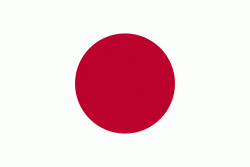Japanese yen
Â¥
The yen (円) is the official currency of Japan. It is the third-most traded currency in the foreign exchange market, after the United States dollar (US$) and the euro. It is also widely used as a third reserve currency after the US dollar and the euro.The New Currency Act of 1871 introduced Japan's modern currency system, with the yen defined as 1.5 g of gold, or 24.26 g of silver, and divided decimally into 100 sen or 1,000 rin. The yen replaced the previous Tokugawa coinage as well as the various hansatsu paper currencies issued by feudal han (fiefs). The Bank of Japan was founded in 1882 and given a monopoly on controlling the money supply.
Following World War II, the yen lost much of its prewar value. To stabilize the Japanese economy, the exchange rate of the yen was fixed at ¥360 per US$ as part of the Bretton Woods system. When that system was abandoned in 1971, the yen became undervalued and was allowed to float. The yen had appreciated to a peak of ¥271 per US$ in 1973, then underwent periods of depreciation and appreciation due to the 1973 oil crisis, arriving at a value of ¥227 per US$ by 1980.
Since 1973, the Japanese government has maintained a policy of currency intervention, so the yen is under a "dirty float" regime. The Japanese government focused on a competitive export market, and tried to ensure a low exchange rate for the yen through a trade surplus. The Plaza Accord of 1985 temporarily changed this situation; the exchange rate fell from its average of ¥239 per dollar in 1985 to ¥128 in 1988 and led to a peak rate of ¥80 against the US$ in 1995, effectively increasing the value of Japan’s GDP in dollar terms to almost that of the United States. Since that time, however, the world price of the yen has greatly decreased. The Bank of Japan maintains a policy of zero to near-zero interest rates and the Japanese government has previously had a strict anti-inflation policy.
Yen derives from the Japanese word, which borrows its phonetic reading from Chinese yuan, similar to North Korean won and South Korean won. Originally, the Chinese had traded silver in mass called sycees, and when Spanish and Mexican silver coins arrived from the Philippines, the Chinese called them "silver rounds" for their circular shapes. The coins and the name also appeared in Japan. While the Chinese eventually replaced with, the Japanese continued to use the same word, which was given the shinjitai form 円 in reforms at the end of World War II.
The spelling and pronunciation "yen" is standard in English because when Japan was first encountered by Europeans around the 16th century, Japanese (え) and (ゑ) both had been pronounced and Portuguese missionaries had spelled them "ye". By the middle of the 18th century, and came to be pronounced as in modern Japanese, although some regions retain the pronunciation. Walter Henry Medhurst, who had neither been to Japan nor met any Japanese people, having consulted mainly a Japanese-Dutch dictionary, spelled some "e"s as "ye" in his An English and Japanese, and Japanese and English Vocabulary (1830). In the early Meiji era, James Curtis Hepburn, following Medhurst, spelled all "e"s as "ye" in his A Japanese and English dictionary (1867); in Japanese, e and i are slightly palatalized, somewhat as in Russian. That was the first full-scale Japanese-English/English-Japanese dictionary, which had a strong influence on Westerners in Japan and probably prompted the spelling "yen". Hepburn revised most "ye"s to "e" in the 3rd edition (1886) to mirror the contemporary pronunciation, except "yen". This was probably already fixed and has remained so ever since.
Country
-
Japan
Japan (日本, or, and formally 日本国, Nihonkoku) is an island country in East Asia. It is situated in the northwest Pacific Ocean and is bordered on the west by the Sea of Japan, extending from the Sea of Okhotsk in the north toward the East China Sea, Philippine Sea, and Taiwan in the south. Japan is a part of the Ring of Fire, and spans an archipelago of 6852 islands covering 377,975 km2; the five main islands are Hokkaido, Honshu (the "mainland"), Shikoku, Kyushu, and Okinawa. Tokyo is the nation's capital and largest city, followed by Yokohama, Osaka, Nagoya, Sapporo, Fukuoka, Kobe, and Kyoto.
Japan is the eleventh most populous country in the world, as well as one of the most densely populated and urbanized. About three-fourths of the country's terrain is mountainous, concentrating its population of 124.8 million on narrow coastal plains. Japan is divided into 47 administrative prefectures and eight traditional regions. The Greater Tokyo Area is the most populous metropolitan area in the world, with more than 37.2 million residents.
